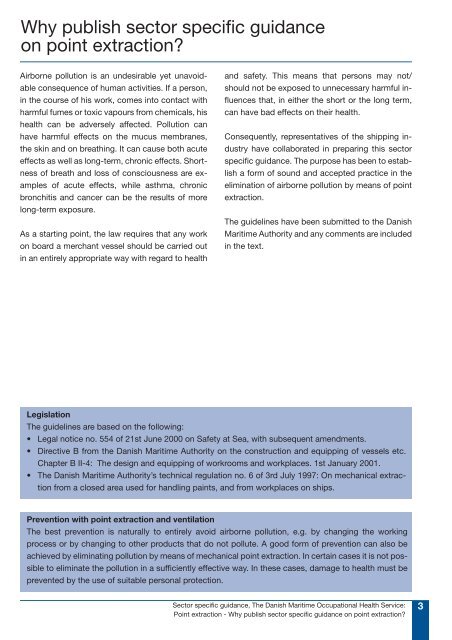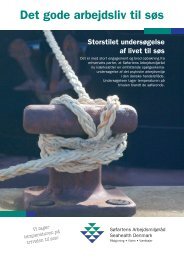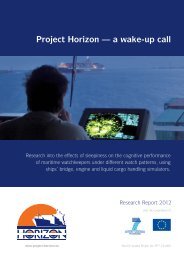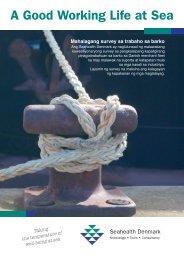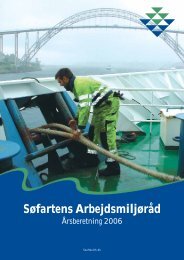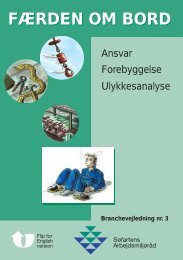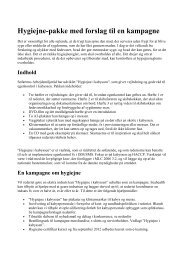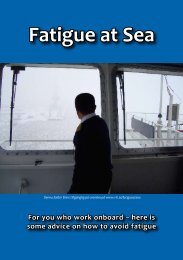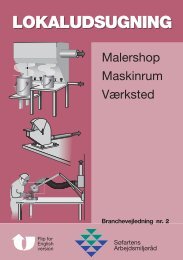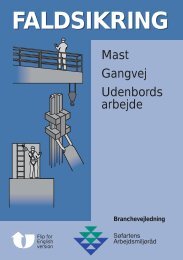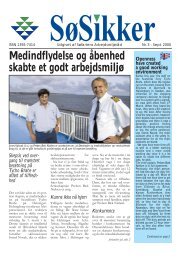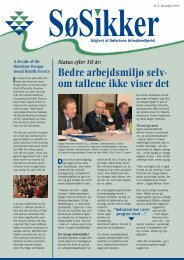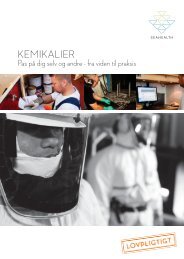POINT EXTRACTION
UK_point extraction2 kor - Søfartens Arbejdsmiljøråd
UK_point extraction2 kor - Søfartens Arbejdsmiljøråd
- No tags were found...
You also want an ePaper? Increase the reach of your titles
YUMPU automatically turns print PDFs into web optimized ePapers that Google loves.
Why publish sector specific guidance<br />
on point extraction?<br />
Airborne pollution is an undesirable yet unavoidable<br />
consequence of human activities. If a person,<br />
in the course of his work, comes into contact with<br />
harmful fumes or toxic vapours from chemicals, his<br />
health can be adversely affected. Pollution can<br />
have harmful effects on the mucus membranes,<br />
the skin and on breathing. It can cause both acute<br />
effects as well as long-term, chronic effects. Shortness<br />
of breath and loss of consciousness are examples<br />
of acute effects, while asthma, chronic<br />
bronchitis and cancer can be the results of more<br />
long-term exposure.<br />
As a starting point, the law requires that any work<br />
on board a merchant vessel should be carried out<br />
in an entirely appropriate way with regard to health<br />
and safety. This means that persons may not/<br />
should not be exposed to unnecessary harmful influences<br />
that, in either the short or the long term,<br />
can have bad effects on their health.<br />
Consequently, representatives of the shipping industry<br />
have collaborated in preparing this sector<br />
specific guidance. The purpose has been to establish<br />
a form of sound and accepted practice in the<br />
elimination of airborne pollution by means of point<br />
extraction.<br />
The guidelines have been submitted to the Danish<br />
Maritime Authority and any comments are included<br />
in the text.<br />
Legislation<br />
The guidelines are based on the following:<br />
• Legal notice no. 554 of 21st June 2000 on Safety at Sea, with subsequent amendments.<br />
• Directive B from the Danish Maritime Authority on the construction and equipping of vessels etc.<br />
Chapter B II-4: The design and equipping of workrooms and workplaces. 1st January 2001.<br />
• The Danish Maritime Authority’s technical regulation no. 6 of 3rd July 1997: On mechanical extraction<br />
from a closed area used for handling paints, and from workplaces on ships.<br />
Prevention with point extraction and ventilation<br />
The best prevention is naturally to entirely avoid airborne pollution, e.g. by changing the working<br />
process or by changing to other products that do not pollute. A good form of prevention can also be<br />
achieved by eliminating pollution by means of mechanical point extraction. In certain cases it is not possible<br />
to eliminate the pollution in a sufficiently effective way. In these cases, damage to health must be<br />
prevented by the use of suitable personal protection.<br />
Sector specific guidance, The Danish Maritime Occupational Health Service:<br />
Point extraction - Why publish sector specific guidance on point extraction?<br />
3


